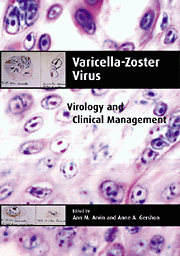Book contents
- Frontmatter
- Contents
- List of contributors
- Preface
- Introduction
- Part I History
- Part II Molecular Biology and Pathogenesis
- Part III Epidemiology and Clinical Manifestations
- 10 Epidemiology of varicella
- 11 Clinical manifestations of varicella
- 12 Epidemiology of herpes zoster
- 13 Clinical manifestations of herpes zoster
- 14 Ophthalmic zoster
- 15 Postherpetic neuralgia and other neurologic complications
- 16 Varicella and herpes zoster in pregnancy and the newborn
- Part IV Laboratory Diagnosis
- Part V Treatment and Prevention
- Index
- Plate section
15 - Postherpetic neuralgia and other neurologic complications
from Part III - Epidemiology and Clinical Manifestations
Published online by Cambridge University Press: 02 March 2010
- Frontmatter
- Contents
- List of contributors
- Preface
- Introduction
- Part I History
- Part II Molecular Biology and Pathogenesis
- Part III Epidemiology and Clinical Manifestations
- 10 Epidemiology of varicella
- 11 Clinical manifestations of varicella
- 12 Epidemiology of herpes zoster
- 13 Clinical manifestations of herpes zoster
- 14 Ophthalmic zoster
- 15 Postherpetic neuralgia and other neurologic complications
- 16 Varicella and herpes zoster in pregnancy and the newborn
- Part IV Laboratory Diagnosis
- Part V Treatment and Prevention
- Index
- Plate section
Summary
Zoster (shingles) epidemiology
Herpes zoster is a common disorder. More than 300000 cases are estimated to occur annually in the United States. With the exception of immunocompromised individuals (particularly AIDS patients), zoster is a disease of the elderly. The incidence among people over age 50 is double that of people under 50 (Harnisch, 1984), which translates into an 8–10 fold increased frequency in people over age 60 compared with those under 60. As the aging population increases (currently 13% of Americans are older than 65), the incidence of zoster-associated morbidity and mortality is also expected to increase. Varicella in infancy may predispose to zoster earlier in life (Guess et al., 1985). The incidence of recurrent zoster is less than 5% (Hope-Simpson, 1965). Although varicella outbreaks occur most often in the spring, zoster may develop at any time of the year. The risk of zoster in vaccinated individuals compared with those who developed naturally occurring chickenpox will not be known for decades. Meanwhile, some investigators have predicted an increased incidence of zoster with widespread use of the live attenuated varicella vaccine (Garnett & Grenfell, 1992; Wharton, 1996).
Pathology and pathogenesis
Despite the ubiquitous nature and frequency of VZV infection, the pathogenesis of zoster remains largely unknown. Our present understanding of virus spread, localization and replication is based on in vitro studies of infected human or primate cells in tissue culture, correlation of the presence of VZV in human tissues with pathologic changes in different clinical situations, and attempts to produce disease experimentally.
The histologic features caused by zoster focus on the dorsal root ganglia and adjacent nerves.
- Type
- Chapter
- Information
- Varicella-Zoster VirusVirology and Clinical Management, pp. 299 - 316Publisher: Cambridge University PressPrint publication year: 2000
- 1
- Cited by

